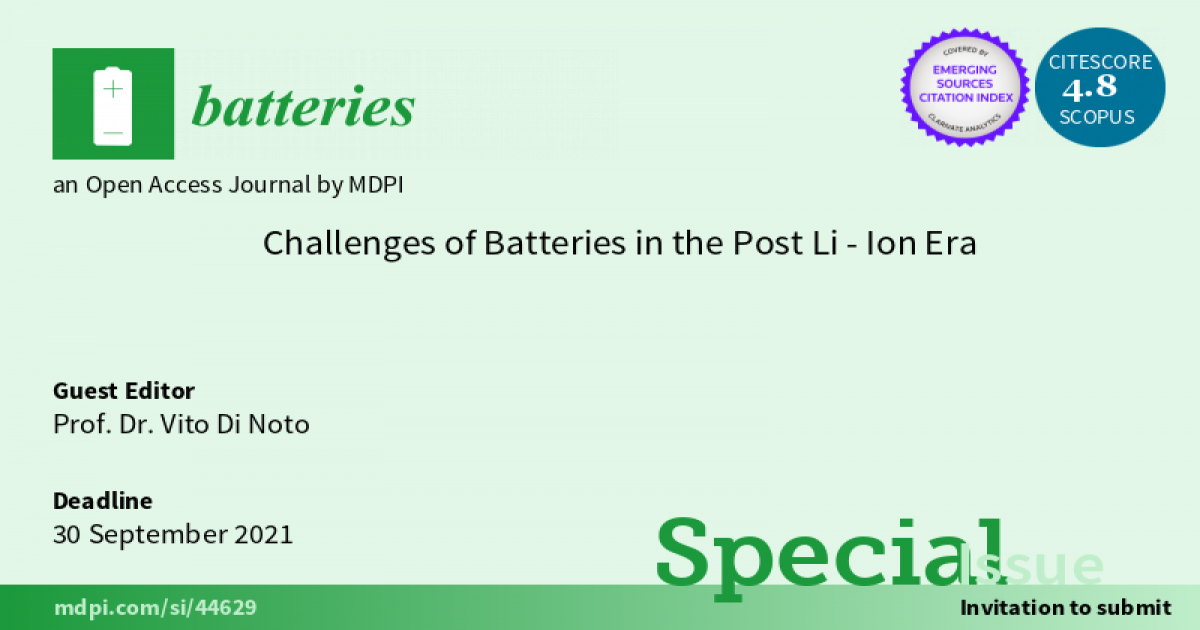Challenges of Batteries in the Post Li-Ion Era
A special issue of Batteries (ISSN 2313-0105).
Deadline for manuscript submissions: closed (30 September 2022) | Viewed by 11763

Special Issue Editor
Interests: electrolyte and electrode materials for energy conversion and storage devices; anion-exchange membrane fuel cells (AEMFCs); proton exchange membrane fuel cells (PEMFCs); high-temperature proton exchange membrane fuel cells (HT-PEMFCs); direct methanol fuel cells (DMFCs); PEM electrolyzers and redox flow batteries (RFBs); polymer electrolytes and electrode materials for secondary lithium and magnesium batteries (beyond Li batteries); study of the electric response of ion-conducting; electric and dielectric materials by Broadband Electrical Spectroscopy (BES)
Special Issues, Collections and Topics in MDPI journals
Special Issue Information
Dear Colleagues,
Lithium-ion batteries (LIBs) are the most efficient systems for energy conversion and storage available on the market today. At present, they are the solution of choice in portable electronics and automotive applications. Unfortunately, LIBs suffer from several drawbacks such as (i) intrinsic limitations in energy density (today 260 Wh/kg or 680 Wh/L); (ii) high costs of raw materials (i.e., Li and Co) due to their low abundance in the Earth’s crust; and (iii) low safety due to the reactivity and volatility of battery components. In this scenario, an urgent need exists for (i) novel systems employing innovative chemistries; and (ii) advanced lithium batteries. The former includes (i) cheap, abundant, and, preferentially, multivalent metals, such as Na+, Mg2+, Ca2+, Zn2+, and Al3+; and (ii) anionic transport media based on F- and Cl-. The latter comprises novel concepts, materials, and designs for lithium chemistry, e.g., (i) lithium-air; (ii) lithium-sulfur; (iii) silicon or lithium metal anode; (iv) high-voltage cathodes; and (v) all solid-state batteries. This Special Issue of Batteries will cover all the above topics, and also fundamental and applied aspects of polymeric and ceramic materials that can be used for the ionic transport of the mentioned ions.
Contributions can include, but will not be limited to the following:
- Silicon or lithium metal anode batteries;
- Lithium-air and lithium-sulfur batteries;
- Ionic transport in post-Li systems (transport of multivalent ions in solids, computational modeling of ion transport, chemical compatibility and interfaces);
- High-voltage cathodes;
- Advanced sodium battery materials (cathodes, anodes, and electrolytes);
- Novel multivalent metal chemistries for electrochemical energy storage (Mg2+, Ca2+, Zn2+, and Al3+);
- All solid-state batteries (ceramic and solid polymer electrolytes, interfaces, and nanostructures);
- Power storage devices (novel designs, geometries, and sensors for monitoring the state of charge, the state of health and the state of function of the battery);
- Applications of electrochemical engineering.
Prof. Dr. Vito Di Noto
Guest Editor
Manuscript Submission Information
Manuscripts should be submitted online at www.mdpi.com by registering and logging in to this website. Once you are registered, click here to go to the submission form. Manuscripts can be submitted until the deadline. All submissions that pass pre-check are peer-reviewed. Accepted papers will be published continuously in the journal (as soon as accepted) and will be listed together on the special issue website. Research articles, review articles as well as short communications are invited. For planned papers, a title and short abstract (about 100 words) can be sent to the Editorial Office for announcement on this website.
Submitted manuscripts should not have been published previously, nor be under consideration for publication elsewhere (except conference proceedings papers). All manuscripts are thoroughly refereed through a single-blind peer-review process. A guide for authors and other relevant information for submission of manuscripts is available on the Instructions for Authors page. Batteries is an international peer-reviewed open access monthly journal published by MDPI.
Please visit the Instructions for Authors page before submitting a manuscript. The Article Processing Charge (APC) for publication in this open access journal is 2700 CHF (Swiss Francs). Submitted papers should be well formatted and use good English. Authors may use MDPI's English editing service prior to publication or during author revisions.
Keywords
- Beyond Li-ion batteries
- Li-air batteries
- Li-S batteries
- Sodium batteries
- Batteries based on multivalent metals
- Solid-state electrolytes
- Electrode materials
- Cell fabrication and testing
- Sensing





